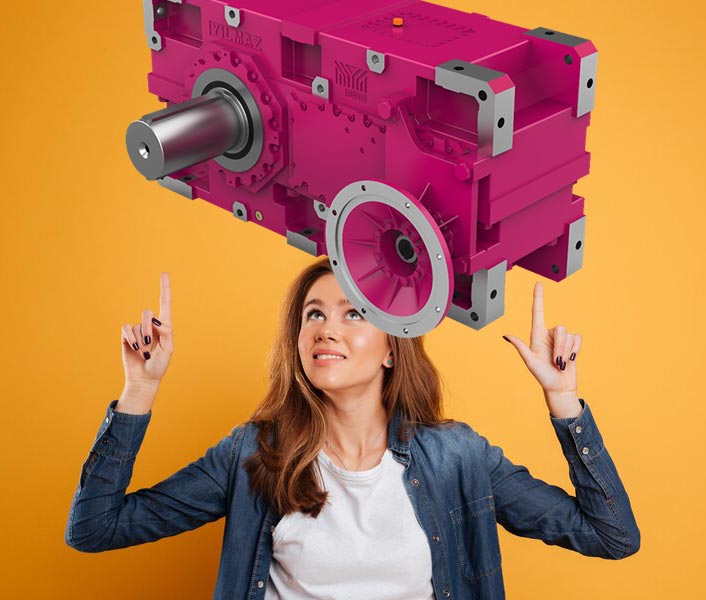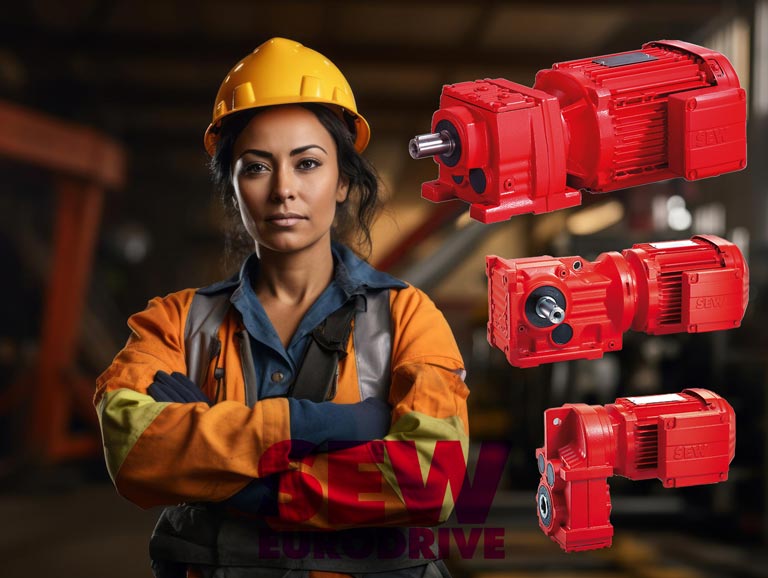What is an industrial gearbox? What do gearboxes and engine gearboxes do? Before buying all types of industrial gearboxes and paying the price of industrial gearboxes, you should know them and familiarize yourself with their advantages and disadvantages. Here we are going to introduce you to the industrial gearbox motor and its applications and introduce you to all the factors affecting the price of the industrial gearbox. Stay with, a supplier of industrial equipment

Table of Contents
- What is an industrial gearbox?
- Types of industrial gearboxes
- Industrial gearbox components
- How does an industrial gearbox work?
- How are gearboxes controlled?
- What is a gearbox motor?
- Types of engine gearbox
- Industrial gearbox buying guide
- Industrial gearbox price
- Buying an industrial gearbox from Sam Tehiz
What is an industrial gearbox?
Industrial gearbox and motor Industrial gearbox is a mechanical device that is used to increase the output torque or change the engine speed (RPM). The motor shaft is connected to the end of the gearbox and through the internal configuration of the gears of the gearbox, it provides a certain output speed and torque which are determined according to the gear ratio.
In short, it can be said that the gearbox is the beating heart and one of the vital components of various industries. The main task of the gearbox is to transfer mechanical power from its production source to the consumer, by reducing the speed and increasing the output torque. The source of power production can be all kinds of electric motors or electromotors, diesel combustion engines, etc.
The price of the industrial gearbox is more expensive compared to the domestic gearboxes. But the application of industrial gearbox is very wide and it can be said that industrial gearbox motor and electric gearboxes are used in all the following industries:
- steel Industries
- Cement, tile and ceramic industries
- Mining Industry
- Automotive industry
- Chemical and petrochemical industries
- Wood and paper industries
- Oil and gas industries
- Packaging and transportation industries
Types of industrial gearboxes
Different types of gearboxes are made all over the world. One of the basic differences between gearboxes is their performance characteristics. The price of the industrial gearbox is also determined by considering these differences. Choosing a gearbox among different types of gearboxes depends on the desired application. Gearboxes are available in many sizes, ratios, efficiencies and backlash characteristics.
All these design factors affect the efficiency and cost of purchasing an industrial gearbox and motor. There are several types of transmissions, which are listed below based on the type of gear (which is the main component of the transmission).
Also, we have categorized gearboxes based on what is known among industries and consumers as below, and more information about each type can be seen in the desired category. Naturally, with the difference in the type of gearbox, you should also expect a change in the price of the industrial gearbox.
- Bevel gearbox
- Simple gearbox (Spur)
- Helical gearbox or direct shaft gearbox
- worm gearbox
- Solar gearbox (Planetary)
- Parallel shaft hanging gearbox
- Cranville gearbox
- Variable speed gearbox

General advantages of industrial gearboxes
The advantages that encourage you to pay the price of industrial gearbox and industrial gearbox motor in different types are as follows:
- Its noise pollution level is low.
- Its efficiency is high.
- The reduction ratio values are large.
- Increases the output torque.
- Reduces output speed.
- It is durable.
General disadvantages of industrial gearboxes
- It is more expensive than other boot systems.
- Good lubrication is necessary to make it work smoothly.
- Poorly cut teeth may cause excessive vibration and noise during operation.
- Quality is an important issue that increases costs.
The disadvantages mentioned above may make you regret buying an industrial gearbox. But also keep in mind that types of industrial gearboxes have been created to make industrial and production activities easier and each of them can work and operate instead of several human forces.
Industrial gearbox components
As mentioned, industrial gearbox motor and industrial gearboxes have different components, the main components of which are the gears of industrial gearboxes. Gears have different shapes and materials depending on the type of gearbox. A change in the type of parts and the internal execution of the gearbox can increase or decrease the price of the industrial gearbox.
Other components of gearboxes are:
- Gearbox shell: The gears are located inside the gearbox shell and its material is usually cast iron.
- Gearbox input and output shafts: which can be hollow or solid shafts and are made of steel.
- Bearing: or bearings that are used to bear the radial and axial loads of gearbox shafts.
- Seal: or felt bowl, which is used to protect the bearings from external factors such as dust and also to keep the oil inside the shell.
- Cap: which is for oil control and inspection.
Need help making a decision?
Take a look at our transmission buying guide
How does an industrial gearbox work?
All types of industrial gearboxes work in the same way. The direction of rotation of the gears depends on the input direction and the orientation of the gears. For example, if the primary gear rotates clockwise, the next gear (engaged with it) will rotate counterclockwise. This process continues until the end of the gear line.
The combination of gears with different dimensions and number of teeth plays an important role in output torque and shaft speed. A high gear ratio makes it possible to increase the output torque and decrease the speed values. While if the gear ratio is low, the output speed will be higher and the output torque will be lower.
You can get the price of solar industrial gearbox from Sam Tehiz.
The solar gearbox works in almost the same way. The solar gearbox system is made with 3 main parts:
- A central sun gear
- A planet carrier (which carries one or more planetary gears)
- A collar (an outer ring)
The central sun gear is rotated by planetary gears (of the same dimensions) located on the planet carrier. Industrial gear motor planetary gears are also mated with sun gear and outer ring teeth with planetary gears.
There are several configurations for the transmission system. Common configurations consist of 3 parts:
- Input parts
- Output parts
- Fixed parts
for example:
One of the possible configurations of industrial gearbox types is to consider the sun gear (as the input part), the collar (as the output part) and the planetary carrier (as the fixed part). In this configuration, the input shaft turns the sun gear, the planet gears rotate about their axes and simultaneously apply a torque to the planet carrier, which in turn torques the output shaft (which is the collar in this example).
The rotation rate of the gears (gear ratio) in the industrial gearbox motor is determined by the number of teeth in each gear. The torque (output power) is determined by the number of teeth and also according to which part is fixed in the solar system.
How are gearboxes controlled?
The output of an electric motor (it means stepper, brushless, AC and brush motors) is used as the input of the gearbox. The output of the electric motor controls the speed at which the gearbox rotates. The configuration below shows an external motor controller driver connected as the input shaft of an industrial gearbox.
As a result of this function, when the driver is activated, the motor shaft inside the gearbox rotates and causes the output shaft to rotate. The output speed and torque also depends on the configuration of the gearbox. The speed and torque of the gearbox is an important factor in determining the price of the industrial gearbox.
What is a gearbox motor?
Industrial gearbox motor, as its name suggests, is one of the important industrial equipments that is made by combining electric motor and gearbox. Gearbox engine plays a role in controlling transmission speed and increasing power. It is impossible to create high torque at low speed without using an industrial gear motor or electric gear. When you are looking to produce large torques for small motors, you should take help from various types of industrial gearbox motors.
The presence of a speed reduction gearbox helps to reduce the output speed of the electric motor, and in the same way, a very large torque can be transmitted. The price of the industrial gearbox motor is also determined by considering the price of the industrial gearbox and the price of the used electric motor.
Among the advantages of motor gearboxes and types of industrial gearboxes, the following can be mentioned:
- Reduction of sound pollution and noise during work
- Increase the life of the device
- Ability to transmit high torque at low speed
- Optimum use of gearbox and electric motor
Types of engine gearbox
The gearbox motor, as the name suggests, is made by combining an electric motor or electric motor with a gearbox and these components are assembled in a simple package. Incorporating an industrial gear motor reduces system complexity and design costs that must be considered to accommodate high torque and low output speed requirements.
Motor gearboxes can be produced as a single unit or by combining separate parts. The meaning of the integrated construction of the industrial gearbox motor is that the motor and the reduction gear are placed on the same shaft. Types of industrial gearbox motors can be divided into the following categories:
- Stepper gearbox motors
- Brushless motor gearboxes
- DC motor gearboxes
- AC gearbox motors
Any type of industrial gearbox motor can be produced with one of the types of simple, sun or helical gears. The price of the industrial gearbox will be determined after specifying the used parts.
Industrial gearbox motors are used in many industrial applications as well as everyday household applications. Industrial applications include cranes, hoists, jacks, and conveyors. Household and daily applications of industrial gearboxes include washing machines, blenders, clocks and hand tools such as drills and dryers.
Industrial gearbox buying guide
When considering and selecting a gearbox, many factors must be considered to meet specific performance requirements. When choosing an industrial gearbox, paying the price of an industrial gearbox and calculating the required input power for an industrial gearbox motor, you should pay attention to the following features:
gear ratio
Gear ratio values are defined as the correlation between the number of teeth of two different gears. Usually, the number of teeth of a gear is proportional to its circumference. This means that a gear with a larger circumference will have more teeth.
Therefore, the relationship between the environment of two industrial gearbox types can also obtain an accurate value of the gear ratio. For example, if one gear has 36 teeth and the other has 12 teeth, the gear ratio will be 3:1.
Output torque
The output torque depends on the value considered for the gear ratio. In order to achieve high output torque, a large value for the gear ratio should be selected. If the value of the gear ratio is large, the speed of the motor output shaft will decrease.
Likewise, by choosing a low value for the gear ratio, the amount of output torque delivered to the system will also be smaller, and the engine speed at the output shaft will be higher. This shows that torque and speed have an inverse relationship with each other.
Speed (RPM)
The speed is proportional to the gear ratio in the system.
For example, if the teeth of the input gear of an industrial gearbox motor are more than the output gear, the result is that the speed of the output shaft increases. On the other hand, if the scenario is the opposite and the number of teeth of the output gear is more than the input gear, the speed in the output shaft will decrease.
In general, the output speed of industrial gearboxes can be determined by dividing the input speed by the gear ratio. The larger the ratio, the lower the output speed and vice versa.
Gear arrangement
The gear arrangement is an innovative engineering design that offers several advantages over conventional fixed gear system design. The unique combination of power transmission efficiency with small dimensions allows to reduce efficiency loss. The more efficient the gear arrangement (means simple, helical, solar, and spiral gears), the more energy is transferred and converted into torque instead of heat loss.
The gear arrangement improves stability and rotational stiffness by balancing the system, but it is complex and increases design costs.
load distribution
Another practical factor that must be considered in the industrial gear motor is load distribution. Since the transmitted load is divided among several planets, the torque capacity is increased. The higher the number of planets in the gear system, the higher the load capacity and the higher the torque density.
Branch
Backlash is the angle around which the output shaft of industrial gearboxes can rotate without moving the input shaft, or the distance between the teeth of two adjacent gears. In non-reciprocating applications, there is no requirement to consider slack. Of course, in precision applications with load return, such as robotics, automation, CNC machines, etc., slack plays a vital role in accuracy and positioning.
Despite all the above, the price of the industrial gearbox should also be considered as one of the features when buying. The budget for purchasing a gearbox should be based on the following points.
Industrial gearbox price
The price of an industrial gearbox is variable and usually depends on the dimensions, specifications related to accuracy, backlash and gear ratio, as well as the manufacturer that produced it. Gears with backlash in the 30 arc-minute range are less than $500. Industrial gearboxes with backlash of less than 5 arc-minutes are more expensive than those with a larger amount of backlash.
In general, the following 6 factors affect the price of industrial gearboxes and you should pay attention to them when buying:
- Type of industrial gearbox: types of industrial gearbox have different prices. For example, the price of the solar industrial gearbox is higher than other types of industrial gearbox because more parts are needed to make it. Also, making a solar gearbox has its own complications and difficulties that cannot be seen in simple gearboxes.
- Materials used in manufacturing: The price of raw materials and primary materials for the construction of the gearbox also affects the final price of the manufactured product. Therefore, when buying a gearbox and an industrial gearbox motor, you should pay attention to their steel, cast iron, wood, brass and iron powder.
- Gearbox size: Larger gearboxes typically cost you more than smaller, less powerful gearboxes.
- Output torque of the gearbox: one of the influencing factors in the price of the industrial gearbox is the torque that is produced to move the gears. More torque output means higher price in the gearbox and you should pay attention to it.
- Output type of gearbox: The output type of gearboxes depends on the type of flange and base and shaft in them. For example, the output of UC and the base and output shaft of the single spike in solar gearboxes increase the price of the purchase cost of the gearbox.
- Currency price fluctuations: The price of an industrial gearbox is affected by currency price fluctuations. The fact that industrial gearboxes are imported causes the rise and fall of the price of the dollar and other currencies to change the final price of the gearbox purchase.
The following is a list of industrial gearbox motors provided by Sam Tehzih. You can contact us to get the industrial gearbox price list and how to order the product.
- Types of industrial helical gearboxes
- Types of straight or helical shaft industrial gearboxes
- Types of hanging industrial gearboxes
- Types of Cranville Pinion industrial gearboxes
- Types of solar industrial gearboxes
- Types of Industrial Helical Industrial Gearbox (Heavy)
Buying an industrial gearbox
supplier of industrial equipment and you can visit REDUCER to buy all kinds of industrial gearboxes at the best price. Since the purchase of an industrial gear motor that fits the needs of the workshop and factory helps to correct the operation of the devices and prevent problems, you should pay the price of the industrial gear and buy it in consultation with expert consultants in this field.
